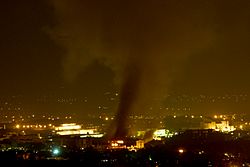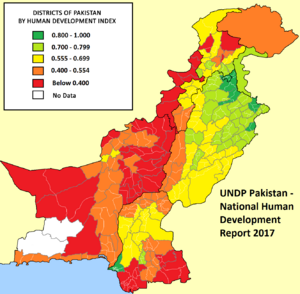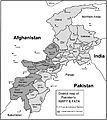War in North-West Pakistan facts for kids
The insurgency in Khyber Pakhtunkhwa, also known as the War in North-West Pakistan or Pakistan's war on terror, is an ongoing armed conflict involving Pakistan, and Islamist militant groups such as the Tehrik-i-Taliban Pakistan (TTP), Jundallah, Lashkar-e-Islam (LeI), TNSM, al-Qaeda, and their Central Asian allies such as the ISIL–Khorasan (ISIL), Islamic Movement of Uzbekistan, East Turkistan Movement, Emirate of Caucasus, and elements of organized crime. Formerly a war, it is now a low-level insurgency as of 2017.
The armed conflict began in 2004 when tensions rooted in the Pakistan Army's search for al-Qaeda fighters in Pakistan's mountainous Waziristan area (in the Federally Administered Tribal Areas) escalated into armed resistance. Pakistan's actions were presented as its contribution to the U.S. War on terror. Clashes further erupted between unified Pakistan Armed Forces and the Central Asian militant groups, allied with the Arab fighters, in 2008–2010. The foreign militants were joined by Pakistani non-military veterans of the Afghan War to the west, which subsequently established the TTP and other militant umbrella organisations, such as Lashkar-e-Islam.
The war depleted the country's manpower resources, and the outcomes outlined a deep effect on its national economy, since Pakistan had joined the United States-led War on Terror. As of 2018, according to the Ministry of Finance (MoF) statistics and mathematical data survey collections, the economy has suffered direct and indirect losses of up to $126.79 billion since 2001 due to its role as a "frontline state". According to the MoF-issued Pakistan Economic Survey 2010–2011, "Pakistan has never witnessed such a devastating social and economic upheaval in its industry, even after dismemberment of the country by a direct war with India in 1971."
After the Pakistani military launched a major offensive against the Pakistani Taliban in 2014, its leaders escaped to Afghanistan. By 2014, the casualty rates from terrorism in the country as a whole dropped by 40% as compared to 2011–2013, with even greater drops noted in Khyber Pakhtunkhwa despite the province being the site of a large massacre of schoolchildren by TTP terrorists in December 2014. The reduction in hostilities eventually changed the conflict from a war to a relatively low-level conflict.
After negotiations, the Tehreek-e-Taliban and the government announced a ceasefire in June 2022. However, on November 2022, the Tehreek-e-Taliban renounced the ceasefire and called for nationwide attacks against Pakistan.
Names for the war
Various names have been applied to the conflict by the authors and historians. Names used in English include: Insurgency in Khyber Pakhtunkhwa, War in North-West Pakistan, Waziristan War, or the Pakistan's war on terror. On the other hand, political scientist, Farrukh Saleem, termed the war as the "Fourth Generation War" or the "4G War".
Peace prospects and developments
Since 2006, major initiatives have been taken out by the government to reconstruct and rehabilitate the war-torn areas of FATA and Khyber Pakhtunkhwa. The military administrator of the National Disaster Management Authority (NDMA), Lieutenant-General Nadeem Ahmad, supervised majority of the socioeconomic development in the areas that were badly affected by the military operations. The government took many initiatives, including promotion the political activities under the Political Parties Act, the construction of the Peshawar-Torkham Road and the establishment of the Investment Bank of FATA, envisioned to bring prosperity and provide employment opportunities. Around ₨ 1 billion were spent for the rehabilitation of the IDPs and ₨ 500 million were immediately transferred into the account of Khyber Pakhtunkhwa government for the economic development in the province.
As of 2006 and present, there are numbers of notable and major international agencies and UN efforts to reconstruct the war-torn areas affected of fighting. As early as 2005, there major government institutions who have been involved in public level to lead the reconstruction, economic development and to bring the quick economic recovery in the war-torn areas, as listed below:
- US Aid
- National Reconstruction Bureau (NRB)
- National Disaster Management Authority (NDMA)
- Earthquake Reconstruction and Rehabilitation Authority (ERRA)
- Special Support Group for IDPs (SSG)
- Federal Relief Commission (FRC)
- National Logistics Cell (NLC)
- Frontier Works Organisation (FWO)
- Navy Reconstruction Group (NRG)
Under the 2006–15 program, a nine-year project, over $2.06 billion would be spend for the economic reconstruction of the FATA region, with the U.S. Government has pledged to provide $750 million over a period of 5 years. Since 2010, the engineering units of army, the Frontier Works Organisation (FWO) and Corps of Engineers and Military Engineering Service, have been active in the area to reconstruct the war-torn areas. Major operations were carried out by the FWO to complete the wide canvas of works, including construction of over 400 km roads, dams, canals and hydroelectric works. The engineering units commenced the work on Gomal Zam Dam in Waziristan with the help of the local tribal people who were employed for this mega project. The Pakistan Army started the political and educational activities after rebuilding the damaged schools and colleges in Waziristan and gave admissions to as many as young tribal teenagers and young men and women in the army institutions since August 2011.
In 2017, Pakistan started constructing a fence along the 2,611-kilometer (1,622-mile) border with Afghanistan to prevent cross-border militant attacks. By August 2021, 90% of the border barrier between the two countries - consisting of 4 meters (13 feet) high chain-link double fences separated by a 2-meter (6.5-foot) space filled with concertina wire coils - was completed.
Casualties
In a debriefing to parliamentarians on 19 October 2011, the ISPR stated that a total of ~3,097 soldiers and personnel were killed and 721 other were permanently disabled in the war on terror. The ISI lost 63 of its personnel owing to targeted assaults on ISI installations. In the same government report, it confirmed that since 2001 a total of ~40,309 Pakistanis, both military and civilian, had lost their lives in the conflict.
Images for kids
-
Air Intelligence map: Map showing the air domain of the districts of the Tribal areas (FATA) and the Khyber-Pakhtunkhwa province of Pakistan.
-
Military intelligence map: In 2007, the Uzbek IMU dominated the South Waziristan before forced out from the country by tribes and the armed forces in 2008.
-
Pakistan airborne forces captured the highest point in Swat valley, 2009.
-
An MQ-9 taking off in Afghanistan.
-
Pakistan's airborne troops performed combat jump operations from PAF's C-130 Hercules aircraft, 2010.
-
A vintage photo of South Wazristan's mountains, primary hideouts of TTP before being pushed to Eastern Afghanistan by the military in 2009.
-
US Defence Secretary Robert Gates laying flowers and straightens out a wreath to commemorate the soldiers and personnel of Pakistan military in 2010.
-
CNS Adm Noman Bashir shakes hand with General David Petraeus to strengthen the partnership with the United States.
See also
 In Spanish: Guerra de Jaiber Pajtunjuá para niños
In Spanish: Guerra de Jaiber Pajtunjuá para niños













